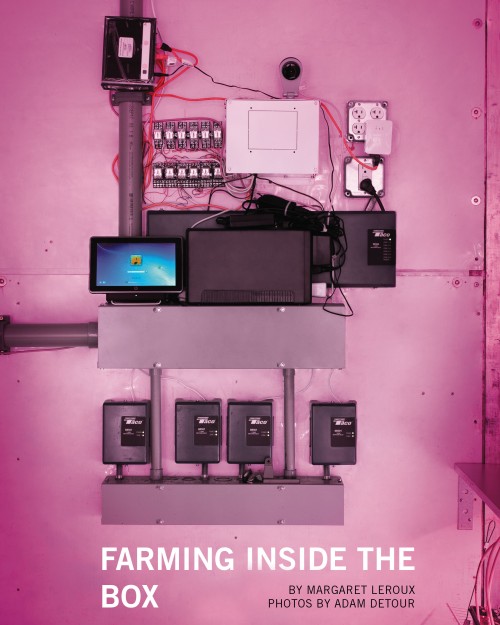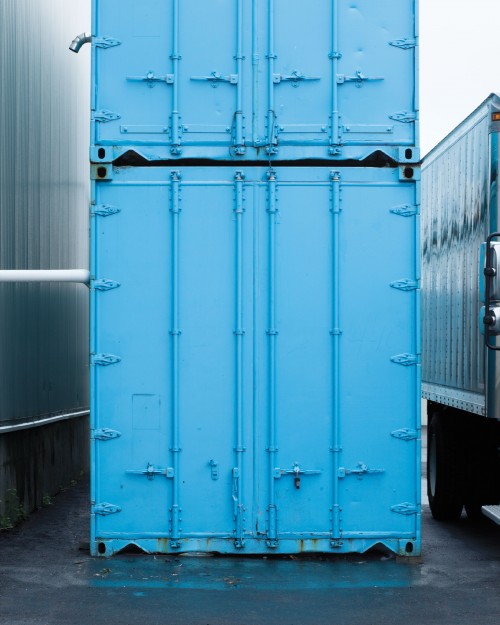Farming Inside the Box
By Margaret LeRoux / Photos by Adam DeTour
On a blistering morning in July the heat seems to amplify the noise and commotion in Newmarket Square, Boston’s food distribution hub. Horns blare as a steady stream of trucks back in and out of warehouse loading docks. At Katsiroubas Brothers Wholesale Fruit and Produce Company, they deliver crates of avocados and grapefruit from California, eggplants from Georgia, blueberries from New Jersey, and strawberries from Ward’s Farm in Sharon, Massachusetts.
Those strawberries and other produce from area farms are at a premium. Although Katsiroubas provides restaurants, hotels, and hospitals throughout the city with fresh produce from all over the country, it’s locally sourced fruits and vegetables that many of their customers want.
“We can’t keep up with the demand for local produce,” says Ted Katsiroubas, great grandson of the company’s founder, who started the business by selling bananas to Boston restaurants in 1914. Ted and his sister, Torry Stamm, now head the company.
Katsiroubas contracts with several farms in the western Massachusetts Pioneer Valley as well as growers in New York, New Hampshire, and Vermont. These are farms at the other end of the scale from the company’s mega suppliers in the Midwest and California. “It’s tough for farmers in this part of the country to commit to supplying enough to meet our customers’ demands,” Katsiroubas says.
Basil is a good example. There’s a huge demand for it from his customers. “I could sell every bunch of basil we get,” Katsiroubas continues, “but the local supply is unpredictable; it’s at the mercy of the weather.” As one of Boston’s certified sustainable business leaders, Katsiroubas Brothers takes a green and creative approach to such challenges. The company found a solution to the local basil problem literally inside a box.
In a small parking lot adjacent to the company’s warehouse is a freshly painted, blue shipping container where a small team of Katsiroubas employees tends a high tech, urban basil farm. In early July they harvested the first sizeable crop of their “Sweet Nily” basil, named for Ted’s son, Nicholas, and Torry’s daughter, Lily. Fifty pounds of the fragrant herb were shipped to Not Your Average Joe’s restaurants. The goal is to reach 300 pounds a week by the end of the summer. Eventually other varieties, Thai and opal basil, will be added.
Katsiroubas’ farm is the product of two young entrepreneurs whose goal is to make urban farming productive in all seasons while reducing the sizeable imprint of food transportation. Brad McNamara and Jon Friedman adapted hydroponic techniques, added cloud-based computing, and housed their urban acreage inside repurposed shipping containers.
The Katsiroubas Freight Farm is the first in Boston. McNamara and Friedman’s prototype is in Worcester where it supplies basil to the Living Earth organic grocery store and to farmers markets run by the Regional Environmental Council. Another Freight Farm is set to open outside of Minneapolis, Minnesota later this fall, with eight more slated for New England before the end of the year.
“We’re not your typical agriculture company,” explains McNamara, “nor are we a typical tech company or a business platform company. A couple of years ago I jokingly said we’re an agtech company; now it’s emerged as a category. We get calls from investors looking to get into agtech.”
Katsiroubas Brothers joined the cutting edge of urban farming as a result of a failed rooftop greenhouse project. McNamara, a Northeastern graduate with an MBA from Clark University, and Friedman, whose degree in industrial design is from Massachusetts College of Art and Design, teamed up to produce rooftop hydroponic greenhouses. Ted Katsiroubas was both a client and sounding board.
“Ted’s project pushed us to the realization that we had to move in a different direction because the cost was prohibitive,” explains McNamara. “The inefficiency of the greenhouse structure bothered me. It was exorbitantly expensive. We realized rooftop greenhouses have a limited ability to affect change.”
As the pair brainstormed new approaches, Friedman was seeking more affordable housing outside Boston. He tapped into cargotecture, the re-purposing of shipping containers into living spaces, and found one on Craigslist. “It turns out it wasn’t an individual selling one shipping container; there’s a whole industry based on buying and selling them,” Freidman said.
Collaborating with McNamara, Friedman soon changed his plan from living in a freight container to growing crops in one. They added light emitting diode (LED) grow lights, heat, ventilation, air conditioning, and a computer controlled system that provides plants with the necessary nutrients and water. The pair partnered to found Freight Farms and conducted a successful Kickstarter campaign, raising $31,000 to buy and outfit their first unit.
Then they took their idea to Ted Katsiroubas. “I am very open-minded, but I remember asking myself, ‘Are they crazy?’” Katsiroubas says. “Plus shipping containers aren’t the sexiest thing—they’re not very aesthetically pleasing. But when I thought about it, a shipping container fits very well within the city. Ultimately, I saw it as an opportunity to make an impact.”
The estimated cost of $60,000 for the Freight Farm unit also convinced him. “On any given week we spend $40,000 just to get produce here from California,” Katsiroubas says. “Anything we can do to get that cost down is a plus.”
In October of 2012 a crane lowered the Katsiroubas farm into the parking lot. It’s made from two reefers (short for refrigerated units), which Freight Farms purchased from Maersk Shipping Lines. The extra unit allows for space on the first floor to operate a clean room to pack the basil for shipping. The first floor also holds two large, plastic tanks. One is for water, the other contains a nutrient mixture; both are piped into trays and towers of bright green basil plants growing upstairs.
Friedman explains, “Using unique vertical growing, we have developed a way to give the plants all the essential nutrients they need without anything they don’t. We have developed an irrigation system that combines hydroponic and aeroponic techniques to allow healthy root and stem growth in a compact environment. Much of our design has been focused around providing a climate for plants to grow to their full size, color, and taste potential without using harmful chemicals, herbicides, or pesticides.”
Sensors monitor water, heat, and lighting, and all the controls are accessed through an iPad mounted on the wall. A carbon dioxide burner attached to a propane heater adds that all-important chemical plants need to grow.
“Everything is digitally monitored and controlled. It’s cloud based farming,” says Freidman. “We supply the original settings, but customers are free to adapt them. If they want to go back to the original settings, they’re all stored on the cloud.”
McNamara explains that he and Friedman are designing an app that will allow Freight Farm customers to operate controls from a mobile phone. “The next step is a network for users so they can share information,” he says.
They have experimented with other crops in their prototype unit: kale, arugula, Swiss chard, and bibb lettuce, for example, but basil’s attraction is its high market value. “Plus, basil typically is shipped from outside of the U.S.,” Friedman notes. “Our customers see added value in being able to sell locally grown basil.”
The shipping container’s design—as a refrigerated unit it’s well insulated—keeps the plants from baking in the midst of Boston’s summer heat waves. “It has a wall-sized refrigerator unit, but we don’t need it to be that cold,” explains Friedman. Instead, the unit’s moderate temperature is maintained with a 14,000 BTU air conditioner, “much more sustainable,” he adds. He and McNamara figure that operating one of their Freight Farms is only one-fifth the cost of a comparably sized greenhouse.
The two also invested a lot of time and effort to make the system simple to operate. “A high school student could run it,” McNamara says.
On the second floor of the Katsiroubas farm, trays of basil seedlings are bathed in a pink glow from LED lights that give them the ultraviolet rays they need to thrive. There are 200 plants in each tray; they grow in rockwool, a horticultural growing medium made from basalt rock and chalk. Long, plastic lines bring water and nutrients from the tanks downstairs. After about a week, the seedlings are transferred to growing towers that look like the rain downspouts on the side of houses. The towers contain reusable growth media and also are blanketed with LED grow lights.
“The entire process is planned to take about five weeks,” says McNamara, who estimates an annual yield of 40,000 viable plants.
The process is efficient; Katsiroubas says his team spends about six to eight hours a week tending the plants. “At this point we’re still learning how to farm,” he says. However they don’t have to do traditional farming chores like weeding or dealing with insects. Nor do they have to worry about heat waves or excessive rain because the Freight Farm is climate controlled.
There’s a rhythm to sowing a volume of seeds and then transferring the delicate young plants from tray to tower. “It’s cool to watch as the team catches on and handles the plants with finesse,” Katsiroubas adds.
Come fall when area farmers harvest the last of their basil crops, the Katsiroubas farmers will be planting new seedlings. The Freight Farm’s insulation will protect them from frost and cold weather. Last winter, the prototype unit in Worcester didn’t need extra heat even in the midst of several snowstorms.
Looking into the future, Katsiroubas would like to see more farms like his in New England. “I hope more people join me and we’ll have a whole network of Freight Farms,” he says. “We distribute over 150 miles from our warehouse; I would love to be able to scoop up products from throughout that area.”
Instead of farm-to-table, will we soon be thinking shipping container-to-table? It may be a whole new approach to urban farming.
This story appeared in Fall 2013.




